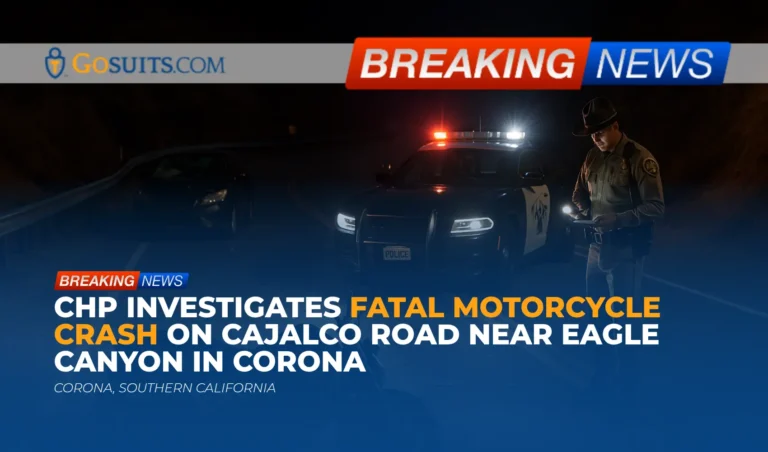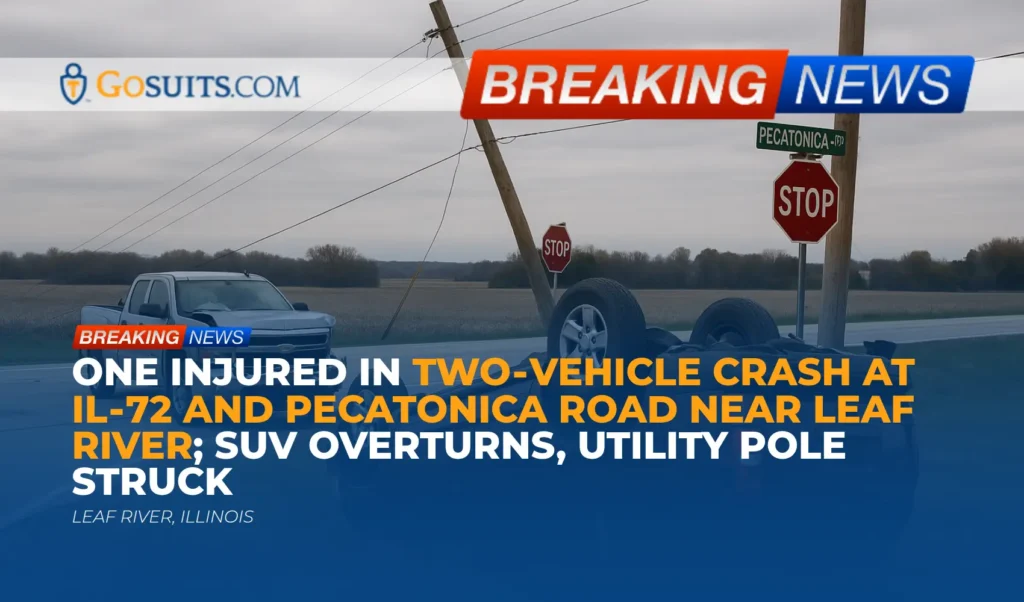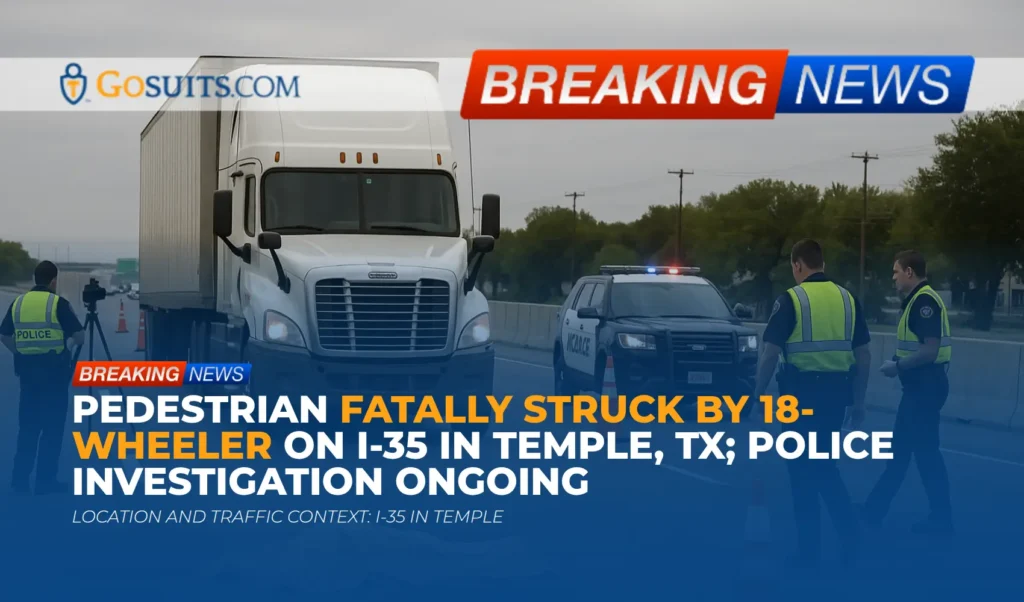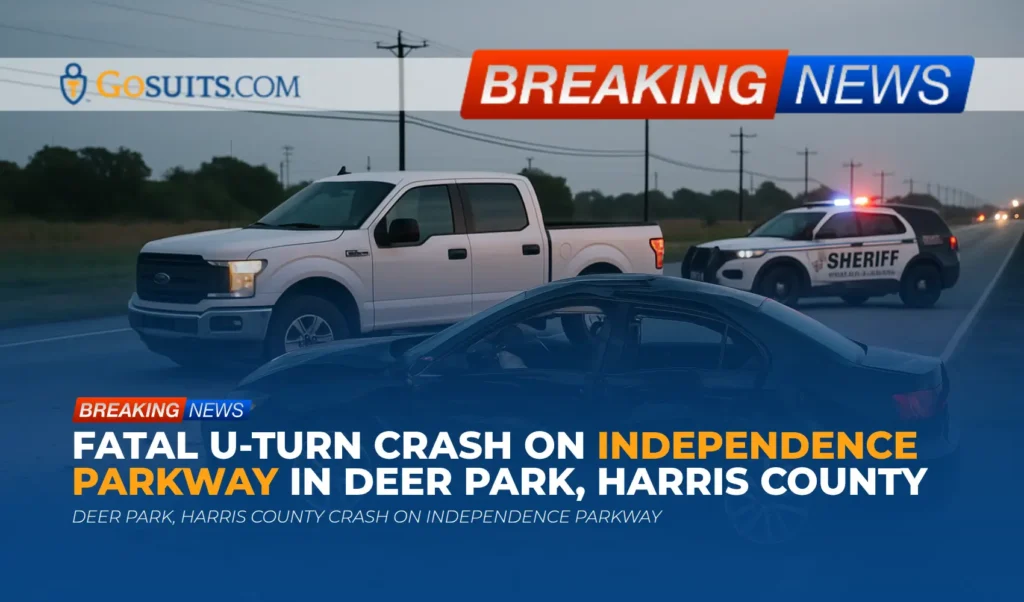- What We Know About the Corona Motorcycle Crash on Cajalco Road
- Location Context: Cajalco Road’s Curves and Guardrails Near Eagle Canyon Road
- How a CHP Investigation Typically Proceeds
- Key Documents to Request and Who to Contact
- Potential Civil Liability and Insurance Issues
- Wrongful Death and Survival Rights in California
- Could Roadway Design or Guardrail Issues Be Involved
- Preserving Evidence After a Motorcycle Crash
- Dealing With Insurance Companies After a Fatal Collision
- Safety Context: Motorcycle Fatalities and Curve Crashes
- Where to Find Support Services
- Commentary from Gosuits Corona, California Personal Injury Attorney
- Why Acting Promptly Matters After a Serious Crash
- Sources and Citations
What We Know About the Corona Motorcycle Crash on Cajalco Road
According to reporting, a fatal collision between a motorcycle and a car occurred in the Corona area of Southern California on Sunday, October 19, 2025, at approximately 8:45 p.m. The crash happened near a sharp turn on Cajalco Road just east of Eagle Canyon Road. The California Highway Patrol is conducting the investigation.
Responding officers found a motorcycle down in the roadway near a car that had front-end damage and a smashed windshield. The motorcycle rider, who has not yet been publicly identified, was sent over the roadside railing and was pronounced deceased at the scene by paramedics. The occupants of the car were treated on scene and were not transported to a hospital. As of the latest information, it was not clear whether alcohol or drugs were factors in the crash.
This is a painful event for all involved. Families and communities feel the shock of a sudden loss, and others at the scene may be coping with trauma. The details below are intended to help explain the process that often follows a serious collision and to outline practical steps people can take to begin gathering information and understanding their options.
Location Context: Cajalco Road’s Curves and Guardrails Near Eagle Canyon Road
Cajalco Road spans challenging terrain in Riverside County. Sections near Eagle Canyon Road include sharp curves and elevation changes. Curves can increase the likelihood of loss-of-control or head-on collisions when drivers cross centerlines, especially at night or when speeds are too high for conditions. Federal highway safety guidance highlights that horizontal curves carry a higher risk of roadway departure crashes and recommends measures such as appropriate advisory speeds, high-visibility signage, and suitable roadside barriers where appropriate. Guardrails are installed to keep vehicles from leaving the roadway at dangerous locations, but their performance depends on speed, angle of impact, and maintenance conditions. In rare situations, a collision can result in a rider or passenger being ejected beyond a barrier depending on impact dynamics.
It is too early to say whether roadway design, surface condition, lighting, or signage played any role in this incident. Those issues, along with vehicle positions and speeds, are part of what investigators analyze. State and federal resources provide general principles for curve safety and roadside barrier use, which can help families understand the types of questions typically examined after a crash.
How a CHP Investigation Typically Proceeds
In California, CHP often leads investigations for serious crashes occurring on state-managed roads or in unincorporated areas. A typical investigation can include the following steps:
- Scene documentation: Officers mark and measure tire friction marks, impact points, debris fields, and final rest positions. They may photograph the scene and vehicles, document roadway geometry, signage, and lighting, and note weather and surface conditions.
- Statements: Investigators take statements from involved parties and witnesses when possible. They may also seek nearby security or traffic camera footage.
- Vehicle examinations: Vehicles are inspected for mechanical conditions relevant to the crash, as well as collision damage that helps reconstruct angle and force of impact. In some cases, investigators may download data from event data recorders in passenger vehicles.
- Toxicology: In a fatal crash, toxicology testing is typically performed through the county coroner’s process to determine the presence of alcohol or drugs, if any.
- Follow-up and reports: The primary Traffic Collision Report is prepared. In more complex or severe cases, CHP may involve a Multidisciplinary Accident Investigation Team for advanced reconstruction. Final reports can take weeks or longer depending on complexity and lab timelines.
Families often want updates. While the investigation is pending, agencies may limit what is released, but certain public records become available upon completion or by request under applicable public records laws. The sections below describe how to request key documents.
Key Documents to Request and Who to Contact
Documenting the facts early can help bring clarity. Several types of records may be available from public agencies and healthcare providers. Each agency has its own procedures, identification requirements, and fees. If a civil claim might be pursued, requesting records promptly helps preserve information while memories are fresh and physical evidence is still available.
CHP Traffic Collision Report
The primary investigative document is the CHP Traffic Collision Report. Next of kin, involved drivers, registered owners, or their insurance representatives can typically request a copy. CHP provides a standard form, CHP 190, and instructions for submitting a request to the area office that handled the investigation. The report may include diagrams, narrative descriptions, listed violations if any, and, in some cases, photographs. Some attachments may be withheld while the investigation is open.
Where to start:
- Request form and process: See CHP guidance on obtaining a collision report and the CHP 190 request form.
- Which office: The report is usually held by the CHP Area Office responsible for the crash location. For a collision near Cajalco Road east of Eagle Canyon Road in the Corona area, the relevant CHP office will typically be in the Inland Empire region. The CHP website lists office locations and contact numbers.
Coroner and Autopsy Records
In Riverside County, deaths from sudden or traumatic causes are generally investigated by the County Coroner, which is part of county law enforcement. Next of kin can usually request the autopsy report, coroner’s investigation report, and toxicology results after they are complete. Processing times vary. Autopsy and toxicology findings can be important in understanding causation and may be relevant if civil liability is evaluated. Counties publish their specific procedures; families can search the county’s official website for “Coroner Records Requests” or call the coroner’s office to ask about next-of-kin access, fees, and timelines.
Death Certificate
Certified copies of the death certificate are issued through the county recorder or the California Department of Public Health Vital Records program. Funeral homes can assist with ordering. Death certificates document the medical cause and manner of death and are needed to handle estate matters and potential claims.
Paramedic and Fire Department Reports
Emergency medical service reports and fire department incident reports typically document the initial medical assessment, resuscitation efforts, and observations at the scene. Depending on local agency policies and privacy laws, next of kin and legal representatives may request copies. If a private ambulance provider responded, requests may be directed to that company’s records department. Local fire agencies often provide instructions on their websites for requesting incident reports.
911 Recordings and Dispatch Logs
Requests for 911 audio, Computer Aided Dispatch logs, and radio transmissions can be made to the public safety answering point that handled the call. Access may be limited or subject to redactions to protect privacy or integrity of an open investigation. These materials can help establish timelines and initial witness descriptions.

Potential Civil Liability and Insurance Issues
When vehicles collide while traveling in opposite directions on a curve, investigators look at several factors. The legal implications depend on the facts and the evidence. Common issues include:
- Lane position and centerline encroachment: Did either vehicle cross into the opposing lane before impact, even momentarily, due to speed, line choice, distraction, or avoidance maneuvers.
- Speed for conditions: California’s basic speed law requires driving at a speed reasonable and prudent for current conditions, even if within the posted limit. Curvature, lighting, and traffic can require lower speeds at night.
- Lookout and reaction: Drivers and riders must keep a proper lookout and take reasonable steps to avoid hazards within the time available.
- Mechanical issues: Brake, tire, or lighting failures can affect responsibility if they contributed to loss of control or visibility.
- Comparative fault: In California, responsibility can be divided among multiple parties based on their percentage of fault. Even if one party bears the majority of responsibility, another party can still bear a share if their conduct contributed to the harm.
Insurance coverage often comes from multiple places in a fatal crash:
- At-fault driver’s liability insurance: May cover wrongful death and survival damages up to policy limits if that driver is found negligent.
- Uninsured or underinsured motorist coverage: The decedent’s own policy or a household policy may apply if the at-fault driver lacks adequate insurance. This requires careful notice and proof, and deadlines can be short.
- Other sources: Potential claims could involve a public entity if a dangerous condition of public property is proven, or a vehicle manufacturer if a defect contributed. These situations are fact-specific and require technical review.
Because recorded statements can affect outcomes, it is generally prudent to consult a personal injury attorney before speaking with any insurance company. What is said on a recorded call can be used later to dispute liability or damages. A free consultation can help people understand rights and obligations before making statements or signing any forms.
Wrongful Death and Survival Rights in California
California law allows certain surviving family members to bring a wrongful death claim when a person’s death is caused by the wrongful act or neglect of another. Damages can include loss of the decedent’s financial support, companionship, and household services, among other losses recognized by law. A separate survival action, typically brought by the decedent’s estate, can seek damages the person would have been entitled to recover had they lived, such as medical bills or lost earnings between injury and death, subject to legal limits.
Important time limits apply:
- General statute of limitations: In most cases, wrongful death actions must be filed within two years of the date of death under California law.
- Claims against public entities: If a public entity is potentially responsible, a government claim generally must be presented within six months of the incident in most personal injury and wrongful death cases. Special rules apply to claim rejection, late claims, and lawsuits that follow.
Eligibility to bring wrongful death and survival claims and the calculation of damages can be complex. Families often benefit from a careful review of the specific relationships, economic circumstances, and evidence supporting liability before deciding next steps.
Could Roadway Design or Guardrail Issues Be Involved
When a crash occurs on or near a curve with a guardrail, investigators sometimes evaluate whether a dangerous condition of public property may have contributed. Examples include insufficient advisory speed signage, inadequate delineation of the curve, poor pavement condition, or barrier placement or condition issues. These cases are highly technical and require expert analysis of design standards and site-specific data. Public entities can be liable for injuries caused by dangerous conditions under certain circumstances, but defenses such as design immunity may apply if the design was approved in advance and met the standards at the time.
If a potential public property issue is identified, claimants generally must file a government claim within six months to preserve their ability to sue later. Meeting these deadlines, gathering maintenance records, and obtaining design documents early can be critical to a fair evaluation.
Preserving Evidence After a Motorcycle Crash
Evidence can be lost quickly after a traffic collision. Steps that can help protect the truth include:
- Vehicle preservation: Ensure both the motorcycle and any involved vehicles are preserved for inspection before repair or disposal. Modern passenger vehicles may contain event data recorder information that can help reconstruct speed and braking. Helmets, jackets, and any onboard cameras should also be preserved.
- Scene evidence: Photographs of skid marks, gouges, debris fields, and roadside features can fade with weather and traffic. Prompt documentation matters.
- Witnesses: Names and contact information for witnesses should be documented as soon as possible. Memories can fade quickly.
- Public records: Requesting the collision report, coroner records, and any available dispatch logs provides a foundation for analysis.
- Spoliation notices: Formal letters asking insurance carriers, tow yards, or other custodians to preserve evidence can reduce the risk of accidental loss.
Dealing With Insurance Companies After a Fatal Collision
Insurance carriers move quickly after serious crashes. Adjusters may seek recorded statements or offer early settlements. There are several reasons to proceed carefully:
- Recorded statements: Anything said can be used to dispute fault or minimize damages. It is generally wise to speak with an attorney first and understand the scope and risks of any statement.
- Policy limits and multiple coverages: Serious losses often exceed a single policy’s limits. Coordinating claims across liability, uninsured motorist, medical payments, and other coverages can be complicated.
- Valuing losses: Wrongful death damages include both economic and non-economic components recognized by law. A complete assessment requires documentation of earnings, benefits, household services, and the family relationship.
- Releases: Signing release documents can end claims permanently. Reviewing language and timing before signing is critical.
Before making a claim or giving any statement to an insurance company, it is prudent to consult a seasoned personal injury attorney for a free consultation to understand rights and potential pitfalls. Insurance companies have adjusters and legal teams focused on managing payouts. Knowing the process can help level the field and prevent unintended waivers of important rights.
Safety Context: Motorcycle Fatalities and Curve Crashes
Motorcycling brings unique exposure to risk because the rider lacks the protective structure of a vehicle. National data show that motorcyclists remain overrepresented in traffic fatalities relative to their share of vehicle miles traveled. Nighttime riding and rural or curving road segments can increase risk due to visibility and roadway departure potential. Federal agencies emphasize measures such as appropriate speeds for conditions, high-visibility gear and lighting, roadway delineation, and well-maintained barriers to reduce severity when departures occur.
For communities, these statistics are not just numbers. Each crash is a person, a family, and a network of friends facing sudden change. Understanding the general risk factors helps inform prevention, but each incident requires a careful, site-specific look at what actually happened.
Where to Find Support Services
Grief and trauma after a sudden loss can be overwhelming. In addition to close family, faith communities, and local counseling providers, the following resources may help:
- Mental health support and crisis counseling: The nationwide 988 Suicide and Crisis Lifeline connects callers with local support 24 hours a day. People can call or text 988 to be connected with trained counselors, including for grief and emotional distress.
- County coroner’s office: The county coroner can guide next of kin through identification, release of remains, and requests for investigation documents. County websites list contact numbers and procedures for next of kin.
- Vital records: Death certificates can be obtained through county vital records offices or the California Department of Public Health, which provides statewide guidance on requesting certified copies.
There is no single right way to grieve. Seeking support is a sign of strength, and it can also help families make thoughtful decisions about the practical steps that follow a tragic event.
Commentary from Gosuits Corona, California Personal Injury Attorney
Our hearts are with those affected by the fatal motorcycle crash reported near Cajalco Road and Eagle Canyon Road. The loss of a life in a matter of moments is devastating, and the shock can be compounded by the uncertainty that follows. This discussion is shared for general information and education. It is not a substitute for personalized guidance on any particular situation.
Crashes on sharp curves raise important questions about visibility, speed selection for conditions, lane position, and whether any roadway features contributed to the sequence of events. A thorough, methodical investigation is essential. That means obtaining the full CHP collision report and attachments, preserving the vehicles, reviewing coroner and toxicology records, and examining any scene data like friction marks, debris patterns, and barrier characteristics. It can also mean looking for third-party video, downloading vehicle data when available, and interviewing witnesses promptly.
In the aftermath of a fatal collision, insurance companies and corporate defendants often move quickly. Adjusters may request recorded statements while people are still grieving or may offer early settlements before the facts are fully known. These tactics take advantage of unfamiliarity with the process and the emotional pressure of the moment. Recorded statements can be used later to dispute responsibility. Early offers may not reflect the lifetime losses families are allowed to claim under California law. Having a skilled advocate review coverage, coordinate with investigators, and manage communications can help ensure decisions are made with full information and without undue pressure.
There is real value in a free consultation before speaking with insurers or signing paperwork. It provides a safe space to ask questions, understand time limits, and plan next steps without cost or obligation. Even if no claim is pursued, the clarity gained can help families navigate an already difficult time with confidence and care.

Why Acting Promptly Matters After a Serious Crash
Several time-sensitive steps can affect the accuracy of the investigation and the ability to seek accountability where appropriate. Acting promptly helps ensure that documents and physical evidence are preserved and that legal deadlines are not missed.
- Preserve the vehicles and gear: Tow yards and insurers may move or dispose of vehicles quickly. Preserving the motorcycle, the other vehicle, and safety equipment allows for inspection and, if needed, data downloads.
- Request core records early: Collision reports, coroner records, and dispatch logs can take time to process. Early requests start the clock and help anchor timelines and facts.
- Identify and safeguard video: Nearby homes or businesses may have security cameras that overwrite footage within days. Rapid outreach can secure copies before they are lost.
- Mark legal deadlines: California’s general two-year wrongful death statute applies in many cases, while claims alleging a dangerous public property condition often require a government claim within six months. Tracking these dates prevents inadvertent forfeiture of rights.
- Be cautious with insurance communications: Statements can be recorded and later used to challenge fault or damages. It is prudent to consult an attorney first for a free review of rights and obligations before contacting any insurer.
- Document economic impacts: Preserve records of funeral and burial expenses, income and benefits, and household services the decedent provided. This information is necessary to evaluate losses under California law.
Taking these steps promptly can make a meaningful difference in clarifying what happened and in ensuring that decisions are based on the best available information.
Sources and Citations
- California Highway Patrol: Request a Collision Report and CHP 190
- California Highway Patrol: How to Obtain a Public Record
- California Vehicle Code section 22350, Basic Speed Law
- California Civil Jury Instructions CACI 405, Comparative Fault
- Code of Civil Procedure section 335.1, Two-Year Limitations
- Code of Civil Procedure section 377.60, Wrongful Death
- Code of Civil Procedure section 377.30, Survival Actions
- Government Code section 835, Dangerous Condition of Public Property
- Government Code section 830.6, Design Immunity
- Government Code section 911.2, Six-Month Claim Deadline
- FHWA: Horizontal Curve Safety Resources
- Caltrans: Roadside Safety and Barrier Guidance
- NHTSA Traffic Safety Facts, Motorcycles
- California Department of Public Health: Vital Records
- SAMHSA: 988 Suicide and Crisis Lifeline






